[ Home | Staff & Contacts | HiFi Playground | Listening tests | DIY & Tweakings | Music & Books ]
Reporter: Carlo Iaccarino
The show took place from May, 18th through May, 21st, 2017 at the M.O.C. facilities, in Munich, Germany
Originally written: May, 2017
Website with plenty of resources: High End Society
Foreword
This year, too, I went to Munich, and I was lucky to find a pleasant weather, despite the bad forecasts.
First of all, I confirm what I already wrote in my previous articles about this show's huge dimensions and variety. This year, I felt that the number of exhibitors increased. This, and my bad schedule, prevented me from visiting all the exhibitors. So I was (I still am) sorry to miss some of them, like Bryston, and their legendary espresso coffee bar :-)
Last year I wondered how the show would have reacted to the retirement of its longtime boss, Branko Glisovic. Actually … we didn’t notice it – evidence of a smooth transition between old and new managers.
So, I found the usual perfect management efficiency and enjoyed a very good show. The visitor is always cared for and his only duty is having fun... Not bad, I'd say. Exhibitors, too, looked unstresssed, so I must assume that they worked well.
My only grumble - and it's a minor one, but shared also with some of the exhibitors - refers to sound leaking from adjacent rooms.
Some - few - systems sometimes played really loud, and disturbed the neighbors. This problem was often worsened because the rooms' doors were left open - but it's normal for an exhibitor to invite people to come in... Yet, I must say that almost all the demos flew flawlessly.
Speaking of the demos, I must express another completely positive comment about the music played.
Both in the magazines and in internet forums, people often criticize the music used for demonstrations at audio shows, always the same, always limited to "audio show old audiophile chestnuts". Now, I don't think those voices have an influence in the real world. Yet, I must say that, in Munich, I listened to very diverse, often unusual, types of music. It surely helped that almost every exhibitor could dig deep into his big music file archives used as musical source.
I also noticed that the use of audiophile classics was felt as something to be avoided, thus, in a politically correct paradox, they were not played at all.
Let me give you an example. The Trinnov room guy asked us what song we'd like to hear to experience the effect of their signal processing, and he was relieved when he could satisfy a request for "The look of love" by Diana Krall. He liked both the song and the artist, but his colleagues from Trinnov previously vetoed that song, plus other audiophile classics, in order not to be accused of relying on "audio show clichés".
During the opening press conference, many things were said. The one that I think may be interesting for our readers is that H.E.S. confirmed that MOC is the most apt place for this show.
Someone objected that the amount of exhibitors is increasing too much. They replied that this year an increase in the number of exhibitors actually occurred, and they run out of the available space, but they plan to expand, next year. They would like to occupy further space on the upper floors in the "Atriums", that is, where the more "traditional" rooms are placed.
Moreover, they are keeping their eyes open on the construction works for another big exhibition facility, that are going on in front of the MOC. There, a big exhibition building is being developed. As far as I could read on several big signs, it is aimed to host car and motorbike exhibitions; yet, I think that nothing prevents those spaces from accommodating machines that produce different types of "sounds". In my opinion, construction works were far from ending, but maybe I'm not taking into account the proverbial German efficiency :-) I hope to give you an update, next year ;-)
I dedicated much of my first day there to the "chatters".
Among them, I'd like to tell you about Bob Stuart's "lecture" regarding his MQA. It is a system he developed to code and transmit high resolution audio files with the certification that they optimally coincide with the original recording. He is now working on MQA full-time - he is indicated as Bob Stuart of MQA, not as Bob Stuart of Meridian any more. This year, his presentation added nothing to his much completer and clearer past speeches on this same topic: you can read, if you want, my 2015 simple-minded synthesis, to which I very inpolitely point you.
Here is real news: a great number of music labels and music distributors came on board, the last one of which is Sony! Almost all the companies that produce players of streams of audio data provide at least their top models with the MQA certification. So, they can write in letterbox that their gear perform the complex operations of unfolding and decoding needed to play a music file with the MQA logo lit on their fascia :-) It may seem a paradox, but this certification can be found also in inexpensive machines. This happens more frequently in the majors' catalogue (like the ones of Onkyo, and Pioneer, that the first acquired), than among the gear of more "audiophile-grade" companies; maybe this is because those high-end companies also happen to have a smaller range of products.
Still, there are many dissidents who produce very updated DACs, capable of decoding the highest resolution signals, yet which didn't sign any deal with MQA. I'm thinking about Playback Designs, whose boss, Andreas Koch, is a strong DSD supporter and a fierce MQA opponent; or Mike Moffat with his Schiit.
Eavesdropping people chattering around the show, my attention was drawn by an observation often heard. We can't be really sure about the acoustic worth of the MQA treatment, because for much of the music, especially old recordings, we can't be sure about what master has been used. And it's very possible that the recording underwent a previous remastering process just to then be passed to production and distribution under the MQA format.
Sure, no light is shed by MQA, either by their - understandable - uncomplete clearing of the technical aspect of this system, or by their licensing strategy. Speaking of the latter, as far as I understood, manufacturers are bound to acquire a bundle of signal processing, MQA not releasing the codes to properly tweak the software that drives the streamers/DAC (AURALiC allegedly initially did this re-programing, albeit without formal authorization - nowadays, not one of Auralic's very updated machines still supports MQA).
Another very interesting presentation was held by Christian Hartmann, resident researcher at the Bavarian Institute of Technology for Broadcasting, who spoke about what seems the "future of audio". We've heard this slogan many times, but now things seem really interesting.
It's the OBA, that stands for Object Based Audio - Anglo-Saxons adore acronyms... As far as I could understand, its' a different way to approach audiovisual production.
Usually, audio signals are routed through the usual path: multitrack recorder-mixing desk-virtual position assignment-final master. This master, in turn, is processed according to the different destinations of that a/v content (stereo, multichannel, plurilanguage, etc.).
With an OBA production, every track becomes a musical "object", featuring its own properties (always assigned during production), that are recorded into metadata files that go with that "object".
Here is the big difference. The final "dress" of this audio product is then built at the customer level, and not - as it traditionally happens - at the mastering stage. This process enables producers to adapt the "dress" of this audio product not only to its musical content, but also to its final user.
So, hypersimplifying, if I am to play this signal with a multichannel system, the different "objects" will carry in their metadata the instructions to know which channel they must be assigned to. But, if I am to play that very same signal with a stereo system, the objects' metadata will tell to the gear (that in both those cases substantially becomes a renderer) which one of them it must place to the left and which ones it must place to the right. And - and that's a really interesting part - if I am to play that musical product with my smartphone's earbuds, those same metadata will tell the renderer inside the 'phone how to reproduce the "objects" which they refer to. This way, the machine can eventually feature dynamic compression, but always respectful of their characteristics. In this way it is – rather, it should be - assured a high quality (tendentially, the highest possible) in every occasion, driving quality either in living rooms or in earbuds.
The goal of this OBA is to make the production independent from the way the end user will play the file. It’s a system that aims at getting freedom from the multiple platforms that nowadays are used for distributing audio productions. This should lead to rationalize production, spending less than for a multiple production of the same product, which is as different as its final destinations. It's an approach conceptually not far from the one that funds MQA. Stuart's solution, too, gives the audio signal a sort of instructions set. The instructions are for the "piece" (software player, streamer, DAC...), outside the recording/mastering studio, that will be in charge of analog signal recreation (here we have the renderer idea again). This system seems to me a valid idea. I guess we can wait and see if object-coded audio will have the same fortune that applied to the object-based informatic programming.
Right now, we can already buy gear enabled to process an OBA-coded audio signal. It can be handled by all the multichannel machines that can process ATMOS and DTS-X signals, plus the DVB-T e MPEG-H tuners. Moreover, OBA productions can be broadcast via the DVB/DVB+ system.
Exhibitors
Here we go, with what particularly woke my interest and that I tried to illustrate with my horrible photos.
RIVIERA AUDIO LABORATORIES
Personal disclaimer: I'm definitively not objective towards this brand. It's the new venture of Luca Chiomenti, an engineer from the northern Italian city Milan who lives, as I do, in the southern Italian city Naples, with whom I not-so-seldom share wine and food expeditions - and you could never tell, looking at his trim figure...
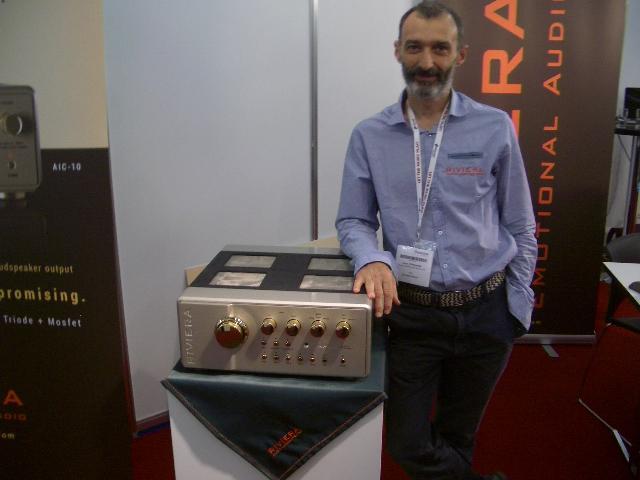
Luca partnered with other foolish pals, among which is Mr.Silvio Delfino, an historic name in Italian High Fidelity. They are making a range of hybrid amplifiers, including one preamplifier, and mono and stereo power amplifiers,
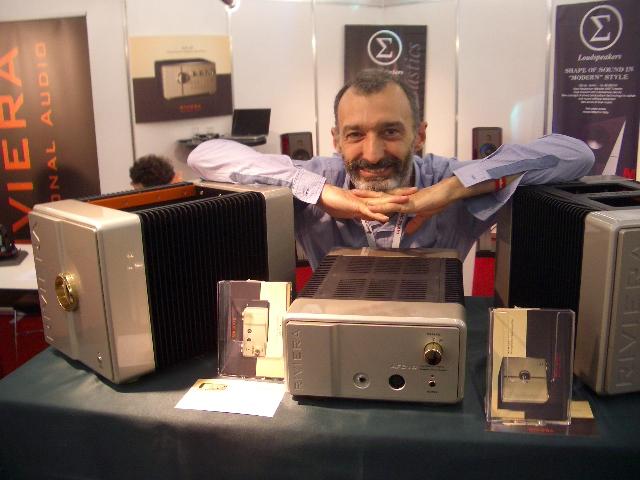
plus an intriguing Headphone Power Amplifier. The latter fundamentally is a can amp, but features such a good power amplifier section, that it can easily drive loudspeakers, too: it's rated at 2 x 10 W/ch @ 8 Ohms.
This brand aims at distinguishing itself also in the way it is marketed to potential customers. They will use the classical information channels (magazine tests are in the work and their ads can already be seen in Italian magazines). Potentially interested buyers can book a listening session of only the models they're interested to, and there will be a strictly reduced number of resellers authorized to manage these auditions. There won't be a "public price list": you won't find'em available from online sellers at strongly discounted prices and there won't be parallel distribution channels.
Luca and Silvio told me those are machines based on a completely personal and, so to say, unusual approach. Circuit topologies and electronic components were chosen when they got good results at the test bench (Luca, after all, it's always an engineer...), yet looking at the measurements that they think are relevant for good listening results, and not, as it often happens, the other way around.... Thus, it's gear that requires quite a dedication. It’s not a light task to design and produce them, nor it is to audition and choose them, nor, lastly, it is to purchase them. Their price will be in the range from EUR 10.000 to EUR 30.000. So, for any further information, you can browse their website to find the closest reseller to which you should direct all your inquiries.
TRINAUDIO
Let's remain in Italy, again heading south, towards Ragusa, Sicily.
I visited Mr.Martorana (yes, another engineer) once again
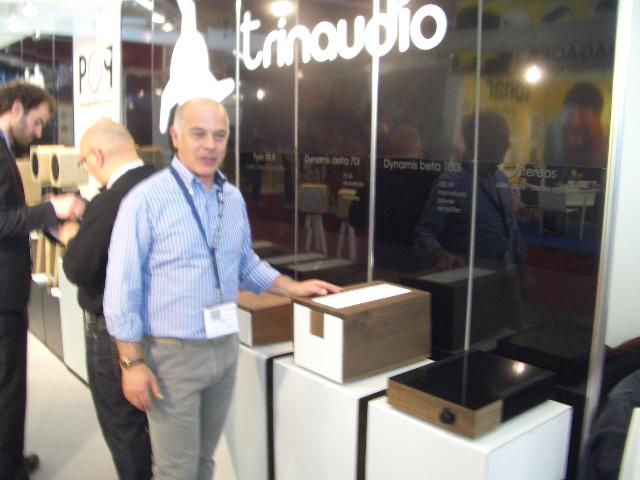
He confirmed that his brand is receiving good international recognition, and he showed me the new gear he developed for the show.
First, he was able to complete his Gyros turntable, now available both in the traditional 9 inch arm version (for EUR 3.700, without taxes; 4.300 with a pre-mounted Jelco arm), and in the new 12 inch arm version (for EUR 4.200, without taxes; 5.070 with a pre-mounted Jelco arm); the new version bears the structural modification needed to balance the more extended armbase.
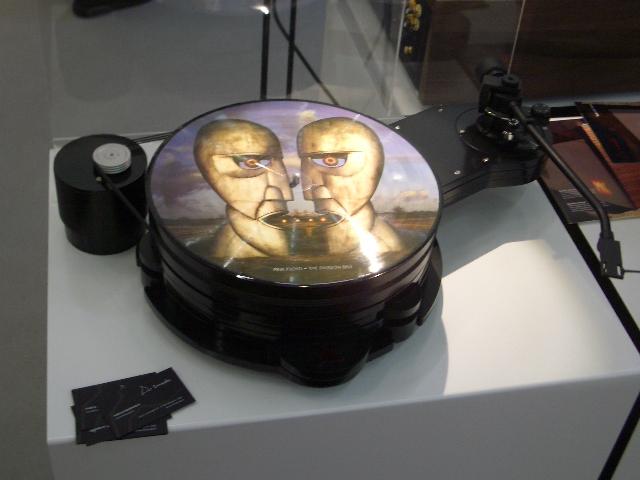
Mr.Martorana told me he improved also his Fysys 35A, a class-A integrated valve amplifier with separate power supply (for EUR 9.950 without taxes). But, more than anything else, he was very proud of his Keleyma rho monos, an MC valve phono preamplifier
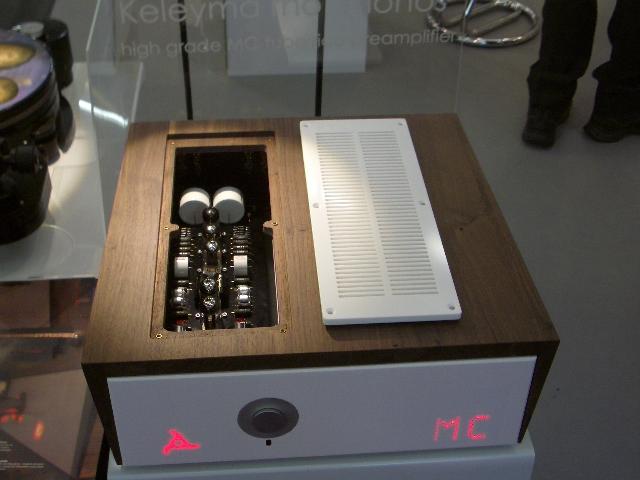
ESTELON
This Estonian firm showed new creations. Starting with their YB floorstanding loudspeakers, for EUR 16.000, that sounded decidedly not bad.
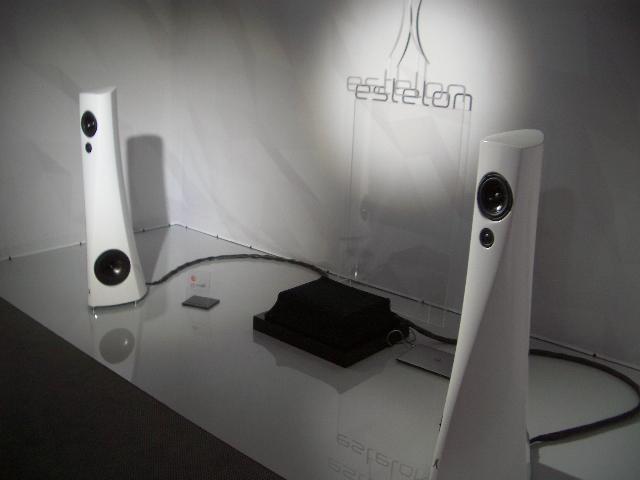
But the real innovation was the machine that drove them and that, probably, was the main reason for the good sound heard in that room.
It's a device that presents one section devoted to process the incoming digital signal. As far as I understood, it works substantially as a HQplayer-based streamer that can also function as a Roon endpoint. It also features another "amplifier" section, that accept a DSD digital signal, applies a power amplification and drives the loudspeakers directly. So, the loudspeakers’ crossover practically performs also the bass-pass filtering theoretically solely needed, with DSD signals, for a proper analog signal reconstruction. It substantially is a "power DAC", that brought back memories of the totally digital amplifier that Sharp introduced at the end of last century (and then discontinued, who knows why).
The device used to drive YB floorstanders was a prototype and, anyway, not available for sale, although its designer told me that, at the show, many people asked him if it could be possible to buy the loudspeakers in bundle with their amplifier. No way, for now; but this result is already available with another loudspeaker model, maybe more fascinating. It's the Lynx (for EUR 40.000 for the diamond tweeter version; EUR 50,000 if you want a beryllium tweeter).
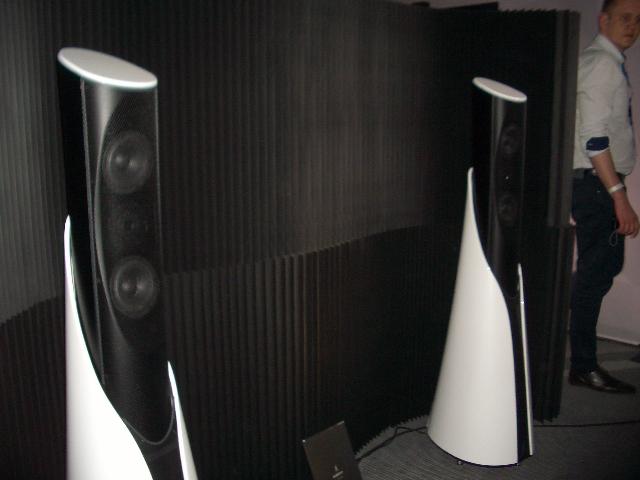
These loudspeakers feature, internally, that electronic parts that were found in the separate device that was driving the YBs. So, the Lynxes are powered speakers that can also directly accept a digital signal input. Moreover they can accept also a wireless signal. They work with a complex and proprietary system that uses a second radio wave carrier to transport a very precise and very fast sync signal. Every dac inside the loudspeakers is slaved to this sync signal, to avoid any phase shift among the loudspeakers.
All this electronic apparatus, that makes for a wireless and boxless audio system, is called Estelon Intelligent Audio.
The Linxes sport also this brand’s signature mobile mid-high section – it can automatically rise or dive, according to the room and the listening position.
It actually is an innovative approach; or if not original, for sure unusual and certainly well realized. The Munich exhibition was a world premiere, and the Linxes suffered some sync signal stability problems. So, sometimes the loudspeakers muted, as predicted by the system when a perfect in-phase emission for both speakers cannot be guaranteed. Maybe this was due to the strong interference from the myriad of wifi LANs of all the exhibitors; a domestic environment should be less polluted.
But it's a brilliant solution. And potentially not limited only to a stereo pair: you could place in the room as many loudspeakers as your wireless LAN can manage. In the near future it may be possible to digitally distribute not only a plain stereo signal, but also a multichannel one. This will lead to an unparalleled easy installation, both electrical and aesthetic. For every loudspeaker you just need a power outlet and a link to your wireless home network, to accept digital stream, either external (e.g. Tidal), or internal (e.g., our musical files placed into our NAS), and you will command everything with Estelon's own app.
It really looks a futuristic approach, at least for someone who, like me, is a baby boomer. Maybe it will appear as a common idea for someone who is a millenial, provided there is one, among them, interested in paying so much for listening to the music at home...
LAB 12
This year, too, I couldn't help passing by to say hello to our Greek friends from LAB 12, for the traditional collective photo. Unfortunately, this year the group was back to its usual composition, because an evil father preferred a Bavarian holyday to its parenthood duties... well, I did the same, anyway :-)
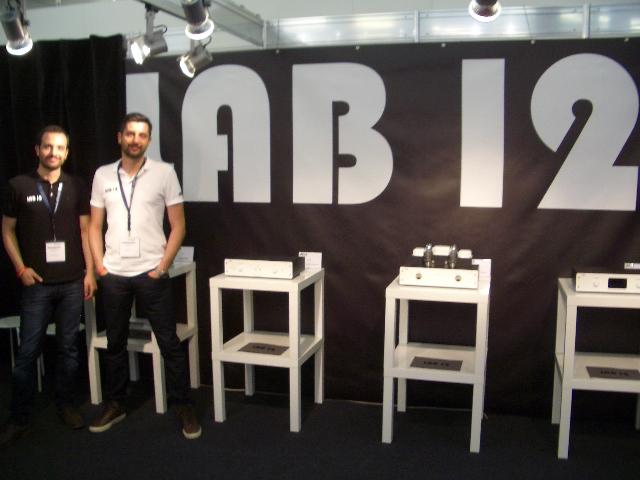
The guys confirmed that this past year was a good one, and pointed me towards two new devices they prepared for the show.
The first one is the Melto2, a widely configurable phono valve preamplifier, whose introduction is scheduled after this summer, for about EUR 2.600, without taxes.
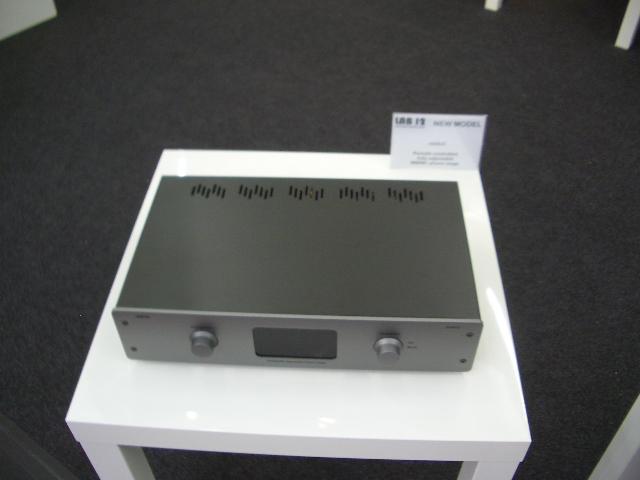
The second piece of news was the Noyra, a 6-outlet power distributor. Its' almost the little brother to the Gordian, but without its sophisticated active electronic AC monitoring. It’s introduced at the decidedly more affordable price of about EUR 900. Here I took a picture of its "B side". It is definitively more interesting than its front panel, consisting of a 50 mm. aluminum slab with only the status LEDs.
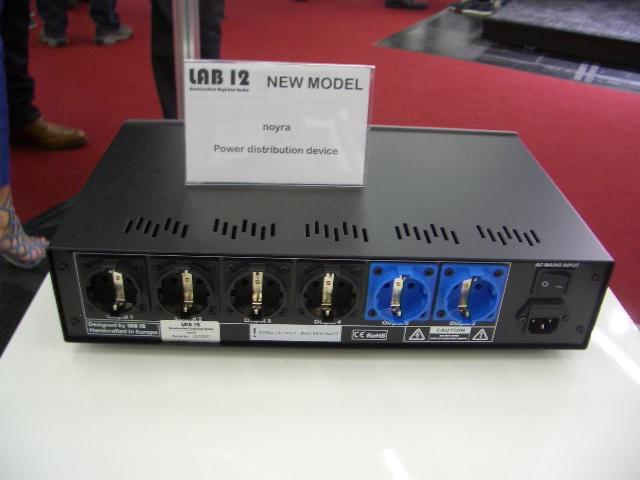
TAD
It's always a reference in the whole show: the TAD big room at the end of the aisle. It's not a mystery that I appreciate TAD's sound very much, and this year, too, I wasn't disappointed. Usual triumphant sound for the "big" rig, consisting of their top electronics and their top loudspeakers, at real estate prices.
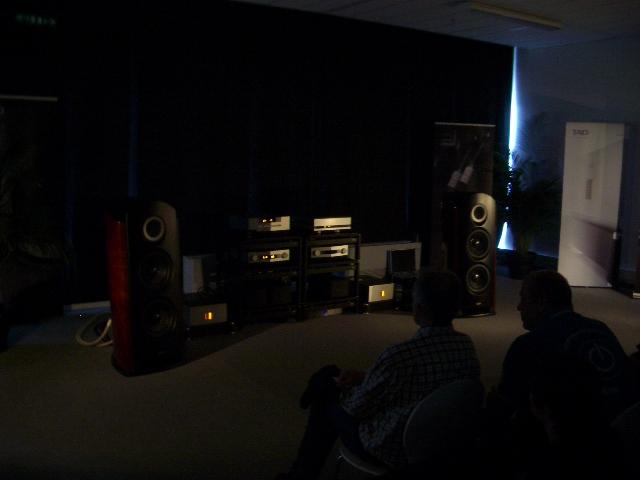
But I was overly curious about their new 3-way bookshelf loudspeakers, the MICRO EVOLUTION ONE.
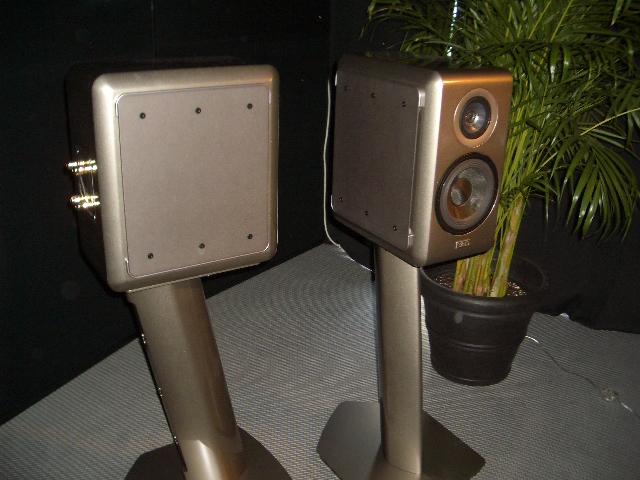
They are the entry level of the Evolution range, and can be yours for EUR 14.500, including VAT and stands (TAD says they are dedicated and - of course - mandatory). It's a model that TAD already exhibited last year, but as a prototype – they clearly aimed at an anticipation effect, to grow the interest in listening to them in their definitive version.
They sport a concentric driver for mids and highs, one of the main features of the entire range; and there's also an original low frequency port that breathes from the speaker's side walls, creating a sort of laminar flow of air.
It's not fair to ask from the lower model a performance similar to its bigger siblings; yet, in the case of the Micro Evolution One, you can - no, you MUST - ask for it! These loudspeakers played very well, balanced, pleasant, with extended lows and refined highs. Summing up, for me – and for other showgoers I spoke with - you immediately perceive their (good) family sound. Of course, the demo was played at (not much) lower volume than the one used with the bigger system. This was probably due to the fair respect of the rules that H.E.S. imposed (but without enforcement...) for the highest level to reach in order not to disturb the neighbors too much. Yet, this circumstance revealed a big plus of these Micro Evolution One: they can perform not that much differently than the unobtainable bigger models, in the "more normal" conditions of home use.
Many of us listen in an urban flat. This means that our listening space is surrounded by neighbors and shared with the other members of our family. We listen in rooms of normal size, not dedicated nor acoustically treated, and can count upon a good, but not huge, money availability. Thus, we could never even legitimately aspire to place into our homes the Reference loudspeakers that voiced the bigger TAD's rig. Right to meet these surely more common needs, TAD made this new loudspeaker. It's not the speaker that has limits influencing its use; it's its possible use to be limited, and the loudspeaker is designed keeping in mind this limited conditions of use.
Once again, I must praise TAD's wise commercial strategy, and, since I'm lazy, I'm going to repeat what I wrote, again from Munich, about last year's demo. We only have to congratulate with TAD for their choice not to direct their productive resources to another top-of-the-line. They have one, already, and it's hardly improvable; maybe they thought it more useful to direct their effort, in budget and design (that shows to proceed, even after head designer Andrew Jones - who also fairly gave to TAD's staff all the credits for the M.E.O.s - left for ELAC), towards an "uncovered" area, where they see bigger margins for the return of their work. I'll close with one last positive fact: their price is also slightly lower than the initially announced EUR 20.000...
ELAC
Excuse me, I couldn't resist the temptation of the dumb connection between TAD and ELAC. Both brands make loudspeakers designed by Andrew Jones who, as soon as he left TAD, developed the first loudspeakers for ELAC. They immediately achieved a huge success, both in selling and in reviews. Those models were very appreciated also because they were very inexpensive and dared to play damn good, too.
This year, Jones brought to Munich the floorstanders ADANTE AF-61, for EUR 6.000: a price not low, but absolutely far from the typical top-of-the-line models, and this makes them, imho, affordable. Here we go, again, with the very concrete, foot-on-the-ground approach, that now can be seen in many brands that are aiming at a real commercial return.
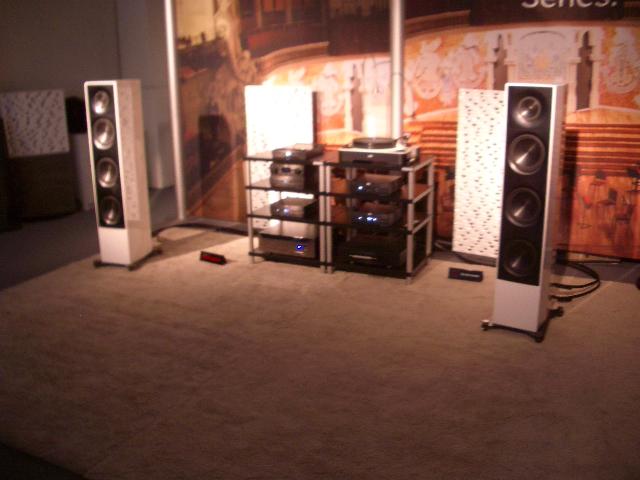
It's Elac's newest model - literally: Jones told us he flew carrying with him the definitive crossover and drivers, and finished, in the show room, their assembly in the cabinets that were already shipped to Munich to prepare the exhibition space.
Adante FS features sophisticated technical solutions. First, the concentric driver, Jones' signature. Then, the three woofers that you can see on the front panel. They actually are drone cones, that close a vented double volume, inside which the real active drivers emit their sound. It seemed to me a variant of the visible double asymmetric load. My ignorance, and Jones' comprehensible shyness on deeper details, prevent me from telling more about it (I'm looking forward to reading the complete technical analysis that Gian Piero Matarazzo is preparing for Italy's Audio Review magazine). Anyway, every time I entered the room to listen to that system - yes, I kept returning there... - I liked very much its sound.
Yet, what sounded so good was an entire system, composed of not only Jones' loudspeakers, but also of the gear designed by Peter Madnick. He is the boss of the Audio Alchemy brand, that Elac acquired as soon as he revamped it. For Elac, Madnick developed a series comprising the old devices originally introduced under the previous A.A. brand and now put in ELAC's catalogue as the Alchemy range, plus a range comprising new gear expressly designed in ELAC. Among them, the analogue preamplifier with integrated DAC AS-DDP 12 and the stereo power amp AS-DPA 12, each for about EUR 2.500,
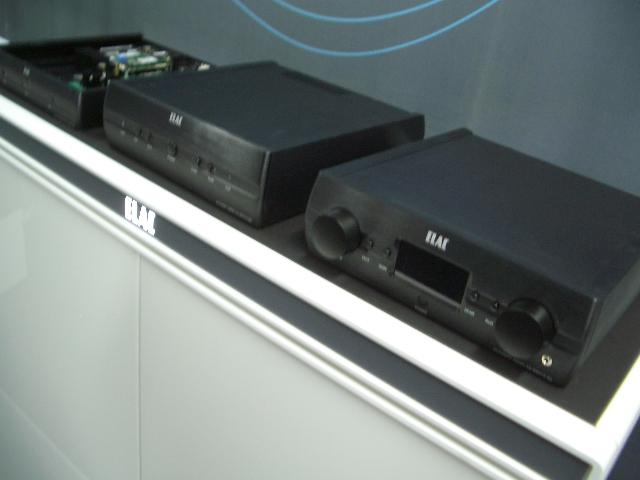
and the DS-SQ201, whose (very badly shot) rear view here I give you.
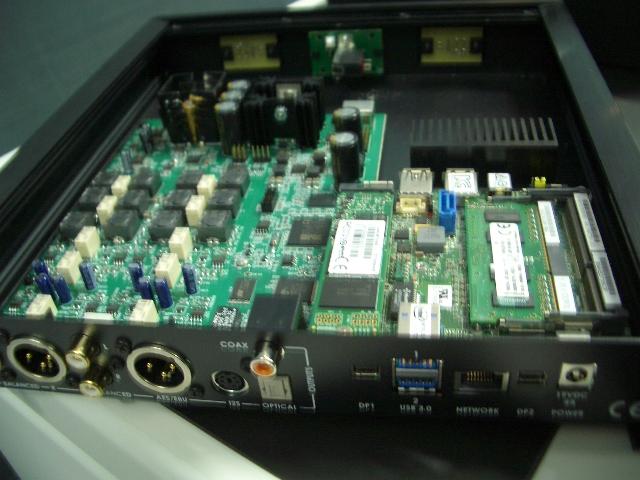
Under its hood you can find a microcomputer and a daughter board - where Madnick's magic concentrated - that is in charge of receiving digital data from the network or from other audio sources, converting them into analog, and driving a refined stereophonic output stage. It's a streamer, and also a DAC, and is a Roon endpoint, too, with a one-year full subscription to Roon included in its price that, for this device, too, is about EUR 2.500.
Elac exhibited also lots of other devices and loudspeakers, designed and realized by its own resident staff, all of them very interesting. Here, I point you to the DS.5101G, an anonymous silvery little box, rather heavy for its size, that functions as a streamer and network player, with Roon Essentials (this reduced Roon version doesn't expire...). All for about EUR 1.100. Besides, there was the AM 200 two-way active standmounter, featuring a modern version of the classic dr.Heil's AMT tweeter, with digital and analog inputs, for the interesting price of EUR 1.200/pair.
Speaking again of standmounters, I finally want to tell you about the ADANTE range standmount loudspeaker, originally named AS-61 (the range will complete with a center channel - you guess - AC-61), for a projected price of about EUR 3.000, roughly half the floorstanders'. Here it is, in the alternative dark veneer respect to the one seen for the AF-61 tower.
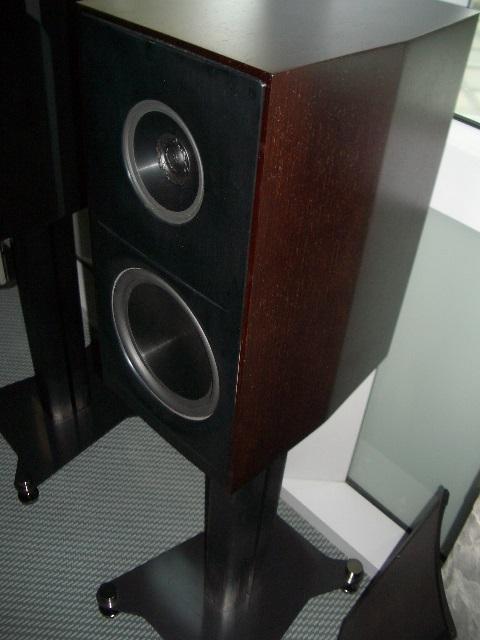
TECHNICS
Nowadays, the pivotal element of this brand's exhibition is the twelvehundred.
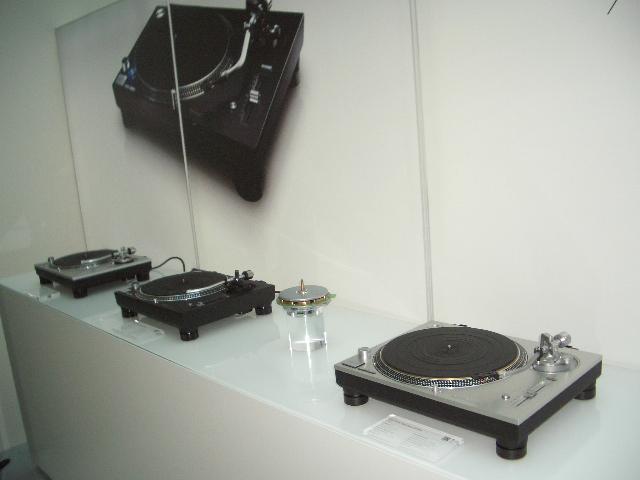
All started last year, with the introduction of the very expensive SL 1200 GAE version, made to celebrate its rebirth and whose entire production batch is said to be sold out. Today also the SL 1200 G model is available, for EUR 3.500. It is substantially similar to the GAE version, but with an improved motor. Maybe more interesting, it is available also the SL 1200 GR model. The latter sports a motor of lesser performance than the upper models, but newly developed. It mounts a gimballed arm with the tube made of aluminum, instead of magnesium, yet this, too, is newly developed. The SL 1200 GR is a deck very close to the original SL 1200 MkII, also regarding its price, of about EUR 600, that makes it certainly more affordable (unfortunately, at the moment the English version of this article is being published, its street price happens to be almost twice as that...).
Technics exhibited a double system, to play with both these new versions. Its setup maybe was not completely casually inspired to this turntable's traditional "natural ecosystem", in which you seldom didn't see it side by side with his twin…
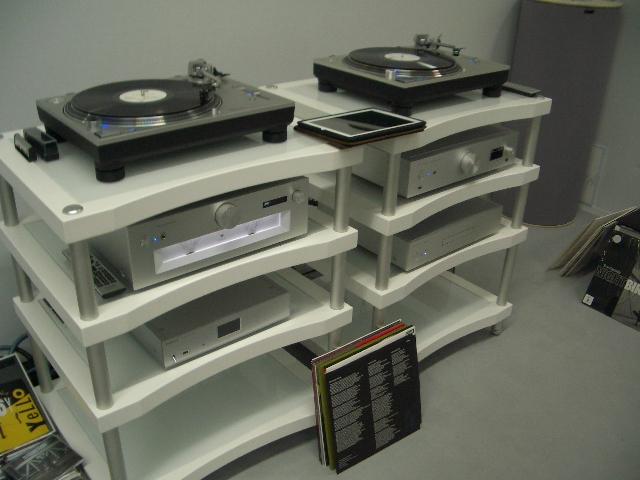
This system comprised also new amplifier models, that, now, keep phono signal processing entirely into the analog domain. Among those, I point you to the new SU G 700 integrated amplifier. It sports also Technics' system for automatic adaptation to loudspeakers' impedance and phase characteristics, a feature initially developed for their big monoblocks and then trickled down towards inferior models.
Speaking of loudspeakers, the exhibited twin system drove, alternatively, the two new floorstanders. They are the SB R 1, for about EUR 20.000/pair, and the SB C 90, for a more affordable EUR 4.000/pair approximately.
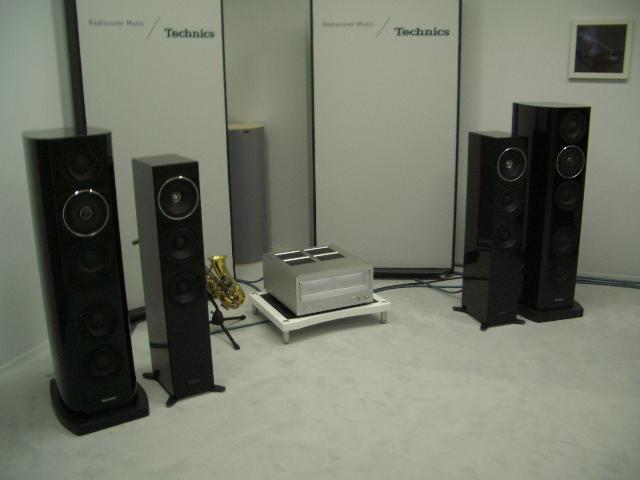
Q ACOUSTICS
The British firm Q Acoustics exhibited its new CONCEPT 500 loudspeaker, for about EUR 4.500/pair.

My horrible photo doesn't pay the right tribute to the quality of its craft and to the its elegant and trim shape. Like all their models, it's built in China and designed by Q Acoustic. This firm, for this particular model, totally relied on the FINK Studio, that is, Germany's bigger loudspeaker maker, also for the OEM market. Fink took care of the whole project and also developed the drivers dedicated to this loudspeaker. For the cabinet, Fink opted for a composite wall that alternates MDF with other materials, ending up with something much more damped than a traditional wood cabinet of the same thickness. During the demo we were invited also to perform the classic rap-knuckle test on a slab of this multilayered material :-)
TOTEM ACOUSTICS
Speaking of loudspeakers, you can NEVER miss the exhibition of this Canadian factory, even only for the entertaining demos held by its volcanic boss, Mr.Vince Bruzzese.
This year, Bruzzese surprised the attending public with his new TRIBE TOWER loudspeakers: I shot some pictures, but they were unfortunately too ugly to be published. It’s a two-way floorstander, costing about EUR 6.000/pair, whose drivers are made by Totem itself. They sport a mechanical crossover for the low frequencies. Their footprint is really reduced, especially considering the quantity of bass produced. Another strong point of these loudspeakers was their very good spatial reconstruction and the balance among the whole spectrum, not constricted by their placement. Bruzzese, in fact, moved them while playing, even rotated them, and the end result didn't change that much or evidently lost balance. With his usual mix of attitude and pride, Bruzzese much underlined these speakers' unusual freedom of placement. He said that they were fundamentally an evolution of their KIN Mini system, that I appreciated several times in my previous Bavarian tales. Moreover, he stressed how these loudspeakers have been obtained with efforts in research and crafting innovations, so he's serving "not the same soup…"
The demo included also the ELEMENT METAL, floorstanding loudspeakers belonging to an upper range, for about EUR 20.000/pair.
Other news was the SKY range loudspeakers, comprising the standmounter, for about EUR 2.500, and the floorstander, the SKY TOWER model, for about EUR 3.000.
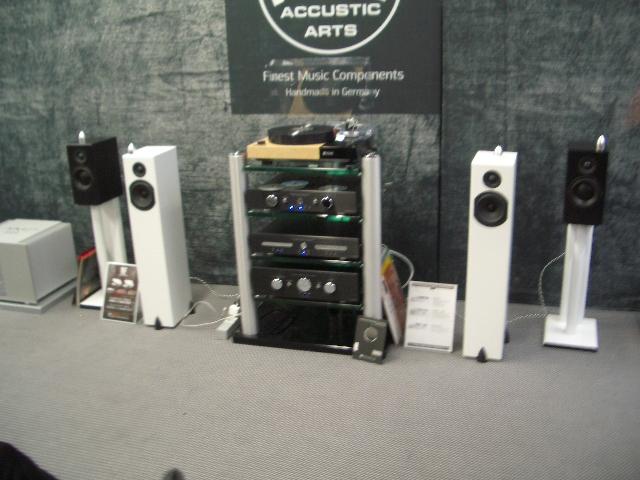
I listened to the Tower model, and it, too, seemed very balanced. It was clearly inferior to the Tribe Tower, nonetheless not a "shortcut": I would like to listen to it in a more friendly room and in more quiet conditions.
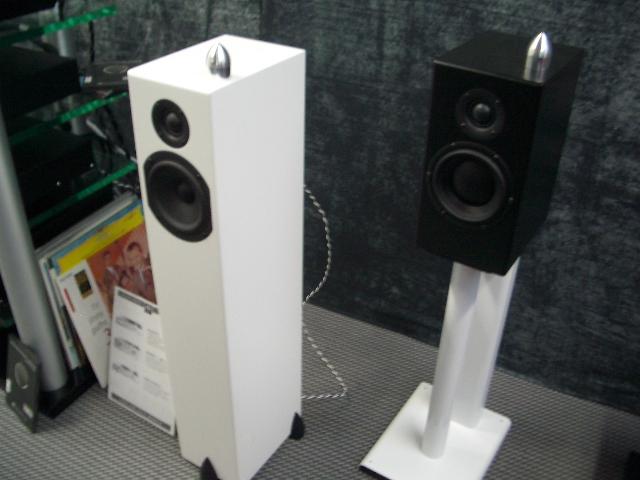
In the end, I was satisfied to see another big producer directing its effort to a sector that, while not cheap in absolute terms, is certainly affordable for an enthusiast. Probably this consideration is even truer if related to their domestic market, made of buyers whose wages have more buying power than their European counterparts.
Well, I think it can be enough, as a first part. Right now, I'm stopping here.
Go ahead to [Part II]

© Copyright 2017 Carlo Iaccarino - www.tnt-audio.com
[ Home | Staff & Contacts | HiFi Playground | Listening tests | DIY & Tweakings | Music & Books ]





















